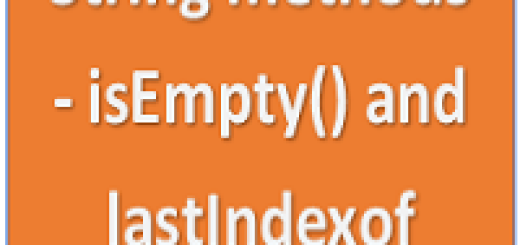Abstract class and Interface
In the previous post, we have seen Polymorphism which is one of the concept of Object Oriented Programming. Before moving to explanation of Abstract class and Interface , let’s understand the Abstraction first.
What is Abstraction in java?
Abstraction is nothing but hiding the internal details and showing only the functionality to the user.As an example you can think of a TV. We watch our favorite channels but we are not bothered about its internal working. Its functionality is only visible to us.
So, we can say that abstraction shows us what it does instead of how it does. Abstraction can be achieved in the following ways mentioned below.
- Abstract Classes (Partial Abstraction or say 0 to 100%)
- Interface (Full Abstraction or say 100%)
Now, we have understood what is abstraction. It is time to move on to understand Abstract classes and interfaces.
First, let’s see what is Abstract Classes.
Abstract Classes:
Abstract class has the following features.
- The class is declared with abstract keyword.
- Abstract class can not be instantiated. e.g. A a = new A();// not possible
- It can have one or more abstract method. A abstract method is which has empty body.
- Another class has to implement all the abstract method of abstract class by using extends keyword.
Example of Abstract class:
abstract class AbstractExample {}
Example of Abstract Method:
abstract void run();
Example to understand the Abstraction using Abstract class and method:
There is an abstract class called Machine which has an abstract method. Another class Desktop is extending parent class Machine.
abstract class Machine {
abstract void turnsOn();
}
class Desktop extends Machine{
void turnsOn(){ //Implementing the abstract method
System.out.println("Starts a Desktop");
}
public static void main(String[] args) {
Machine D = new Desktop();
D.turnsOn();
}
}
Abstract Class which has constructor, abstract and non- abstract methods:
abstract class Machine {
Machine(){ // Constructor
System.out.println("Machine constructor");
}
abstract void turnsOn(); // Abstract method
void makesNoice(){ //Non-abstract method
System.out.println("Machine makes noice");
}
}
class Desktop extends Machine{
void turnsOn(){ //Implementing the abstract method
System.out.println("Starts a Desktop");
}
public static void main(String[] args) {
Machine D = new Desktop();
D.turnsOn();
D.makesNoice();
}
}
Machine constructor
Starts a Desktop
Machine makes noice
When to use abstract class?
- Abstract classes or method are declared as abstract when two or more subclasses are expected to fulfill a similar role through different implementation.
- When there is a requirement to declare a class which hold both abstract and non-abstract methods.
Another way to achieve the abstraction id via Interface.
Interfaces:
Interfaces have the following features.
- Interfaces are used to achieve fully abstraction i.e. 100 % abstraction.
- Interfaces have method body without any implementation.
- Multiple inheritance is possible through Interfaces.
- Interfaces can not be instantiated.
- Interfaces also represents IS-A relationship.
- It can have constant, static methods and nested types.
- Interfaces can be implemented by the classes using implements keyword and extended by another interface using extends keyword.
- By default, it is assumed to add public and abstract keywords before the interface method and public, static and final keywords before data members.
Let’s understand these points in details.
Example of interface which is having abstract methods and those abstract methods are implemented by child class.
interface Machine {
void turnsOn(); // Abstract method
void makesNoice();
}
class Desktop implements Machine{
// All abstract method have to be implemented
public void turnsOn(){ //Implementing the abstract method
System.out.println("Starts a Desktop");
}
public void makesNoice() { //Implementing the abstract method
System.out.println("Desktop making noice");
}
public static void main(String[] args) {
Machine D = new Desktop();
D.turnsOn();
D.makesNoice();
}
}
Starts a Desktop
Desktop making noice
Compiler adds public and abstract keywords before the interface method and public, static and final keywords before data members:
 Interfaces can be implemented by the classes using implements keyword and extended by another interface using extends keyword:
Interfaces can be implemented by the classes using implements keyword and extended by another interface using extends keyword:
Interface helps to achieve multiple inheritance as shown in the below figure.

A class can implement multiple interface as shown in the below example. That’s why achieves multiple inheritance.
interface Machine {
void turnsOn(); // Abstract method
}
interface Table{
void keepOnTable();
}
class Desktop implements Machine,Table{
// All abstract method have to be implemented
public void turnsOn(){ //Implementing the abstract method of Machine interface
System.out.println("Starts a Desktop");
}
public void keepOnTable() { //Implementing the abstract method of Table interface
System.out.println("Keep desktop on the table");
}
public static void main(String[] args) {
Desktop D = new Desktop();
D.turnsOn();
D.keepOnTable();
}
}
Starts a Desktop
Keep desktop on the table
Example of interface extends another interface:
package com.test;
interface Machine {
void turnsOn(); // Abstract method
}
interface Table extends Machine{ // Interface extends interface
void keepOnTable();
}
class Desktop implements Table{ // Only table interface is implemented , it takes method of Machine as well
// All abstract method have to be implemented
public void turnsOn(){ //Implementing the abstract method of Machine interface
System.out.println("Starts a Desktop");
}
public void keepOnTable() { //Implementing the abstract method of Table interface
System.out.println("Keep desktop on the table");
}
public static void main(String[] args) {
Desktop D = new Desktop();
D.turnsOn();
D.keepOnTable();
}
}
Starts a Desktop
Keep desktop on the table
Interface can be nested:
One interface can be placed in another interface known as nested interface.
interface Machine {
void turnsOn(); // Abstract method
interface Table{
void keepOnTable();
}
}
Marker or Tagged Interface:
An interface which does not have any thing like method, data member etc. known as marker interface. e.g. Serializable, Cloneable etc.
//marker interface
public interface Serializable{
}



1 Response
[…] Webdriver is tool or framework etc. But in simple term , we can say WebDriver is nothing but an interface. Selenium WebDriver ,also known as Selenium 2.0 has been designed to overcome of the limitation of […]